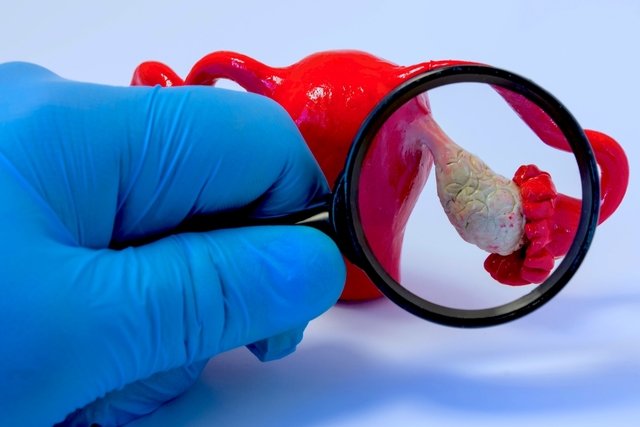Inflammation in the ovaries can cause symptoms such as pain in the lower part of the belly, pain when urinating, pain during sexual intercourse, nausea, constant fever, bleeding outside the vaginal period and vomiting.
Inflammation in the ovaries, also known as oophoritis or ovariitis, in most cases occurs when infectious agents multiply in the ovaries, causing their inflammation. However, inflammation can also be a consequence of other situations, such as autoimmune diseases and endometriosis.
It is important that the gynecologist is consulted as soon as the first symptoms of inflammation in the ovary appear, as this will enable the most appropriate treatment to be initiated and prevent inflammation in the tubes and uterus, which can cause complications for the woman.

Main symptoms
The main symptoms of inflammation in the ovaries are:
- Pain in the lower part of the belly;
- Pain when urinating or during intimate contact;
- Pain in the lower back;
- Vaginal bleeding outside the menstrual period;
- Constant fever above 37.5º C
- Chills;
- Nausea and vomiting.
Additionally, some women who have ovarian inflammation may also have greater difficulty getting pregnant.
How the diagnosis is made
The diagnosis of inflammation in the ovary must be made by the gynecologist based on the initial assessment of the symptoms presented by the woman, in addition to laboratory and imaging tests, such as blood count, erythrocyte sedimentation rate, ultrasound and/or radiography.
Carrying out a well-performed physical examination with bimanual vaginal examination to evaluate the uterus, pain and mobilization of the cervix and appendages and also carrying out a speculum examination resolve the vast majority of complaints of pelvic infection, and the gynecologist, in this way, is able to provide a diagnostic hypothesis.
Consult your nearest gynecologist using the following tool to assess the possibility of ovarian inflammation:
Taking care of your health has never been easier!
Furthermore, when a sexually transmitted infection is suspected, the doctor may also recommend a culture of vaginal secretion in order to diagnose the presence of bacteria.
In more complicated cases, it may be necessary to perform diagnostic videolaparoscopy to directly observe the ovaries. See how videolaparoscopy is performed.
Possible causes
The main causes of ovarian inflammation are:
1. Autoimmune disease
In autoimmune diseases, the immune system itself produces defense cells against the body itself, causing inflammation. Thus, in the case of autoimmune oophoritis, for example, immune cells attack one or both ovaries, causing dysfunction in these organs and causing inflammation.
2. Pelvic inflammatory disease
Pelvic Inflammatory Disease (PID) is an inflammation that begins in the vagina and can spread to the uterus, tubes and ovaries if not identified and treated. PID is usually the result of an infection that has not been properly treated, such as bacterial vaginosis and sexually transmitted infections, such as chlamydia and gonorrhea. Find out more about DIP.
3. Sexually transmitted infection
Sexually Transmitted Infections (STIs), such as chlamydia and gonorrhea, can cause inflammation in the ovaries, bladder and intestine, and leave consequences such as infertility or chronic pain, if they are not identified and treated correctly. This inflammation occurs due to the damage caused by microorganisms to the tissues in which they develop, and it is essential that treatment with antibiotics is started as soon as possible.
4. Cancer
Cancer can cause inflammation of the ovaries when it develops in these organs or when it metastasizes there, causing symptoms such as ovarian swelling, abdominal pain and bleeding outside the menstrual period. See other symptoms of ovarian cancer.
5. Abortion
Abortion can cause pain in the pelvic region and ovaries, in addition to causing bleeding that can last between 2 and 3 days. This happens because abortion causes inflammation in the ovaries, which can subside in a few days.
6. Endometriosis
Endometriosis is a chronic inflammatory disease, that is, it develops over time, causing inflammation and leading to the appearance of symptoms. Endometriosis is the abnormal growth of endometrial tissue outside the uterus, in places such as the ovaries, fallopian tubes, intestine or bladder, causing symptoms such as severe pelvic pain, very heavy menstrual flow and excessive tiredness. Learn more about endometriosis.
Types of inflammation in the ovary
According to the cause, ovarian inflammation can be classified into some main types:
- Autoimmune inflammation, when it occurs due to an autoimmune change, in which the body itself attacks and tries to destroy the ovarian cells. It is the most serious type and can lead to infertility and even surgery to remove the ovaries;
- Chronic inflammationin which inflammation occurs over time, being mainly related to endometriosis, which is characterized by the growth of the endometrium outside the uterus, causing progressive inflammation of the ovaries and other organs in the region;
- Acute inflammationwhich is usually related to a sexually transmitted infection, in which the infectious agent causes inflammation of the ovary and the appearance of symptoms.
It is important that the type of inflammation in the ovary is identified by the gynecologist so that the most appropriate treatment can be recommended.
Treatment of ovarian inflammation
The treatment of ovarian inflammation must be guided by the gynecologist according to the cause, and the use of medication or surgery may be recommended.
1. Use of medications
If the inflammation is caused by microorganisms, the doctor may recommend the use of antibiotics, such as doxycycline or azithromycin, and anti-inflammatories, such as ibuprofen or even corticosteroids, depending on the case. Additionally, your doctor may also recommend the use of painkillers to alleviate symptoms.
When the inflammation in the ovary is chronic or when the woman also has inflammation in the tubes, hospitalization may be necessary to use medicines that are injected directly into the vein.
2. Surgery
Surgery is usually indicated when inflammation in the ovaries is chronic and/or the symptoms are debilitating and occur frequently, and removal of the ovaries is recommended. Find out how surgery to remove the ovaries is performed.

Sign up for our newsletter and stay up to date with exclusive news
that can transform your routine!
Warning: Undefined array key "title" in /home/storelat/public_html/wp-content/plugins/link-whisper-premium/templates/frontend/related-posts.php on line 12
Warning: Undefined array key "title_tag" in /home/storelat/public_html/wp-content/plugins/link-whisper-premium/templates/frontend/related-posts.php on line 13



